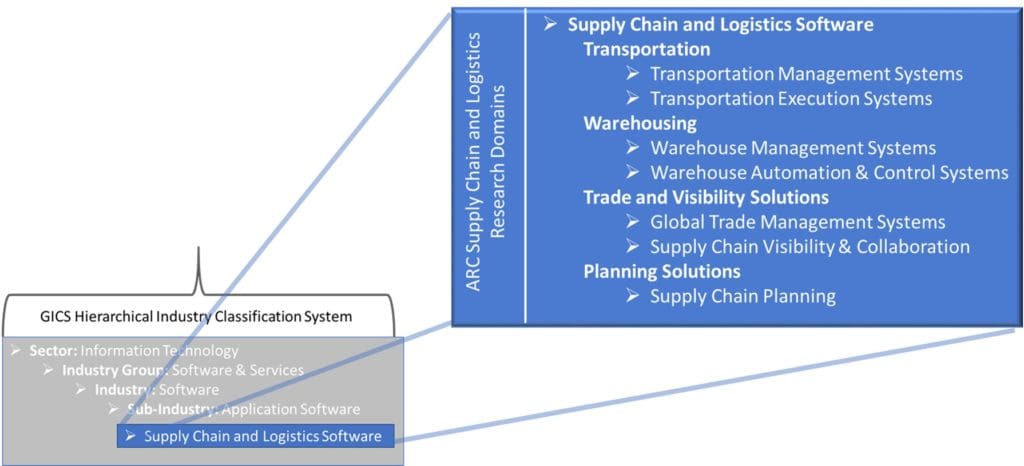My colleagues and I often mention our current research projects in our blog posts, and proceed to note some of the findings or even just some of the considerations at hand. In a recent post, I mentioned “Analysts at ARC Advisory Group receive periodic inquiries from potential investors such as private equity firms and venture capitalists looking to get a better feel for a technology market.” It occurred to me that many Logistics Viewpoints readers may be surprised that private equity firms and other investors would purchase our logistics technology market studies. I personally find the investment research process very interesting, and believe many of you may as well. So I am going to take this opportunity to describe the role our research can play in an investor’s due diligence process.
Industry Research Bridges the Gap
Investors that develop diversified portfolios of securities (think mutual funds) often conduct equity analysis from a top-down perspective. They analyze the economy, then industry prospects, and finally individual companies/equities. Industry insight is critical to understanding the context in which a company operates. However, most investment managers utilize standard industry classification systems such as the GICS to define and analyze markets. These classification systems provide context, but only down to a certain level of specificity. For example, the GICS groups all application software together in its most narrowly defined, sub-industry level. This grouping does not provide the level of detail necessary to distinguish the characteristics of logistics software companies from the larger application software industry. In fact, the logistics software industry is itself a heterogeneous industry with distinct application types. Many equity analysts don’t care to know about these important distinctions. But private equity investors and others interested in purchasing an entire company care greatly about these details.
Industry Insights for Strategic Analysis
Investors looking to purchase a logistics technology company, as opposed to a block of shares, are often doing so as part of a larger growth strategy. They may be looking to enter a strategically important market, enhance or expand a current business with complementary functionality, or substantially change an existing business in some way. To evaluate and maximize growth prospects, they need to determine where opportunities exist. For example, how does the warehouse management systems (WMS) industry growth rate compare to that of the larger application software industry? What segments of the WMS market are expected to grow at the fastest pace and why? Where is the WMS industry in its industry life cycle and how will general technology trends [SaaS, Cloud computing, modern mobility, connectivity in general (IoT)] impact the industry in the near future? They may also look at the evolution of an industry and determine that logistics application types are merging into logistics technology platforms. For example, an investor may look to combine a transportation management systems (TMS) provider with a WMS provider to create a logistics execution technology company. Or they may be looking to create a next generation warehouse technology provider by purchasing a warehouse automation provider and merging it with a WMS provider. The stakes are clearly high when purchasing an entire company, so the investors typically want to know the factors affecting growth of the market to identify a company that is poised to harness that opportunity.
Industry Insights for Company Valuation
Technology investors have an investment strategy, or “thesis” that they are evaluating. There are numerous scenarios under consideration and the impacts of key assumptions provide valuable insights. Revenue and revenue growth are primary considerations for technology investments. Industry growth forecasts can serve as an anchor for the growth expectations of companies that compete in the market. Furthermore, these growth expectations can be modified according to the position of the company with respect to the demand segments for the industry, such as region (ie EMEA or Latin America) or revenue type (SaaS, software license, maintenance and support). In fact, technology investors often use standard valuation multiples for each revenue type. For example, they may say “SaaS revenues are typically valued at 4x, maintenance at 3x, and perpetual licenses at 2x.” This brings me to another valuation method that is frequently referenced – comparable company analysis.
Price multiples such as price-to-revenue and price-to-earnings can be calculated quickly. Even the purchase price and revenues of privately-held companies is often available. However, very often these are not “apples to apples” comparisons because companies’ offerings can differ in a number of ways. For example, how can you determine the value of a company that offers TMS, WMS, and global trade management (GTM) solutions in a different mix than any publicly traded company? One answer is to create a “sum of the parts” valuation by taking industry average valuations for each logistics technology then compute a weighted multiple for the company in question. A similar bottom-up method using industry averages can be used for determining proper discount rates used in discounted cash flow analysis.
Final Word
A few years ago a sell-side equity analyst implied to me that proprietary industry research such as ARC’s logistics technology market studies is unnecessary for thorough analysis of a company’s business. He said that he could quickly and easily pull up similar information in the FactSet database. He was mistaken. Common investment tools, including investment databases and standard industry classification systems do not provide the level of distinction that is provided by ARC’s market studies. These distinctions are often unimportant to those that invest in stocks of companies, but these details are critical to investors that buy entire companies.

















